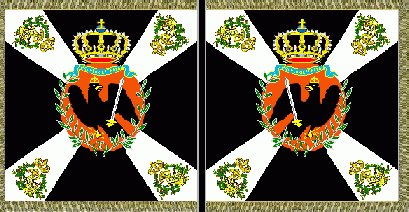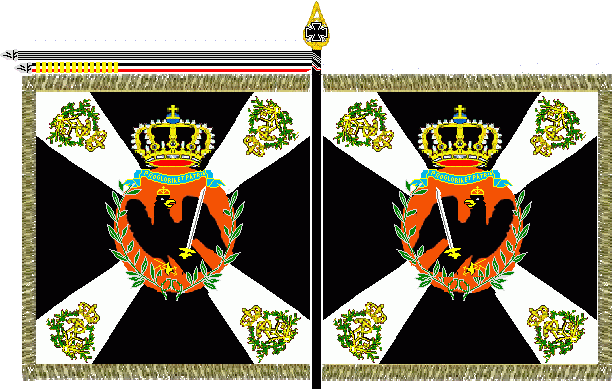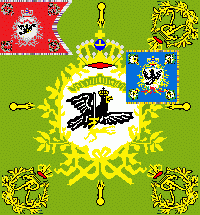
Image by Klaus-Michael Schneider, 23 August 2012

Last modified: 2012-08-25 by pete loeser
Keywords: prussia |
Links: FOTW homepage |
search |
disclaimer and copyright |
write us |
mirrors

Image by Klaus-Michael Schneider, 23 August 2012
The first unit of Hussars in Prussia was established in 1721 as a unit of strangers from Wallachia (men and horses, as well) being part of the Dragoons Regiment No.6. King Friedrich-Wilhelm I recommended to enroll exclusively soldiers from Poland or Hungary, because it was understood that Germans would not be able to do the job properly. For a certain time Hussars had been considered just as a matter of fashion, but King Friedrich II the Great, noticed Hussars being really useful in war and gave them a lot of extra tasks.
Eventually, Friedrich had up to 10 regiments established. Hussars units were not named only by numbers, but by the names of their chiefs, and also had special nicknames and uniforms. Here are some examples:
On 10 August 1803, Georg III, elector of Hannover and also King of Great Britain made a proclamation "to all the brave Germans". As a result "The King's German Legion" (KGL) was established including three regiments of Hussars, in the beginning (until 1809) they were denoted as light-dragoons. The Hussars increased up to 12,000 men, having 3,500 horses.
After the KGL had been dissolved on 23 December 1815, the men of the legion had to be integrated into existing Hanoverian units.
On 1 January 1838, Ernst-August II, King of Hannover, inspired by Prussian units, reestablished two regiments of Hussars, connecting them with the 1st and 2nd Hussars regiment within the King's German Legion, which had been dissolved just before in 1833. They existed until 1866, when Hannover was annexed by Prussia, having been denoted as "Guard's Hussars Regiment" (formerly No.1 of KGL) and "Queen's Hussars Regiment" (formerly No.2 of KGL).
Klaus-Michael Schneider, 28 Aug 2010
As one result of the extension of Prussia after the victory in the war of 1866 new troops were needed. Just one month later on 27 September 1866, the Hussars Regiments no.13, 14, 15 and 16 were established by supreme order of the government. Having not enough troopers, the new regiments were filled by diminishing existing regiments. Regiment No.15 was built by merging the Westphalian Regiments No.8 and No.11 and the new regiment was located in Düsseldorf, while the No.11, formerly located there, was removed to Lüneburg.
Although facing logistical difficulties in the beginning, the regiment held its first review in Düsseldorf on 13 October 1866. In April of 1867, it reached its full size by establishing a fifth squadron.
On 17 November 1867, the unit was renamed the Hannoversches Husaren-Regiment Nr.15. In 1868, the regiment took part in military exercises for the first time. It also took part in Franco-German War (1870-1871) from 24 July 1870 to 2 June 1871, until it was successively withdrawn. There were more losses by diseases (15 men dead) than by action (5 dead, 7 wounded, 1 missing in action).
After the end of war the regiment was removed to Wandsbek (today part of Hamburg), but some parts had to be located in Itzehoe, because there were not sufficient quarters in Wandsbek. During the following years a good relationship between soldiers and inhabitants grew up.
In 1875, the regiment formed a Hussars brigade teaming up with Regiment No.16. On 31 August 1898, the unit was renamed again, this time as the Husaren-Regiment "Königin Wilhelmina der Niederlande" (Hannoversches) Nr.15.
It was a practice among Hussars to choose a "chief", who was entitled to wear the uniform of the unit, but whose main duty was to spend extra equipment to the unit, such as winter-clothing. Being "chief" was an honour, but the "chief" was not a military commander.
Twelve (12) men from the regiment took part in the expedition in China 1900 (the Boxer Uprising). Afterwards little happened to the regiment until World War I broke out, in which the Hussars took part. After the war, the regiment returned to Wandsbek, the regiment was dissolved in the spring of 1919.
Source: Hans-Werner Faerber: "Wandsbeker Husaren", Hamburg 1991; p.8-37
Klaus-Michael Schneider, 28 Aug 2010

Images by Klaus-Michael Schneider, 23 August 2012
There were swallow tail pennants with ratio estimated 5:11, the tail taking approx 45% of total width. According to source those pennants were in use for all cavalry regiments within the Prussian army and the design was the same for all units:
According to sources the patterns of units on foot and mounted units were the same, the former having a flag (Fahne) for each battalion (size: 200cm x 200cm), the latter a guidon (Standarte) for each regiment (size 45cm x 45 cm).
Klaus-Michael Schneider, 28 Aug 2010

Prussian Cavalry Guidon
Image by Klaus-Michael Schneider, 23 August 2012
The flag was fixed upon a black pole of length about 320cm, at its base protected by a 23cm long tube of brass. The finial was gilded showing the king's cypher. The author mentions expressis verbis, that the cypher "FWR" was no error. It should have been "WR", but probably due to a low budget policy the cyphers of the former king had been kept for a while. Another ribbon (Standartenband), length 170cm, width 3,5cm, being striped into black and silver was applicated just below the finial. Due to a fault in material the standard was exchanged and the cypher at the lance head was altered into "WR" by a royal order, because units were not allowed to make any exchanges or alterations by themselves.
By supreme order of the government the finial of the guidon was exchanged a second time on 16 June 1871. All units having taken part in 1870/71 war gained the right to show a black iron cross in the finial instead of the cypher. On 18 August 1895, another black-white-red ribbon as battle honours (Auszeichnungsband) was added. It was fixed at the top of lance, its length was 85 cm, its width 3cm and upon the ribbons small gilded plates of height 1,5cm were fixed carrying the names of every battle or siege, in which the unit took part. At its end was a silver tassel. By the Orders of 14 December 1899, two other single Säkularspangen plates (century plates), made of brass were added to the ribbon. They were rectangular and fixed directly above the tassel, one of them showing the date "1 January 1900" and an image of the imperial crown, the other the cypher "W II" and two dates "1 January 1900" and "19 December 1803", the latter being the day the unit's predecessor was established.
Klaus-Michael Schneider, 28 Aug 2010
Faerber mentions one report, dated 1903, in which two lieutenants of the regiment are describing their standard as black with a yellow disc and yellow wedges. According to Faerber this is impossible and he makes the shocking conclusion that "the soldier does not even know his sacred flag". But I am in doubt, whether Faerber is right. There is one single B/W photo showing the standard on top of the lance, carried by a Hussar in an exercise. The wedges to me seem to be darker than white wedges should be, but I have no proof.
The standard was granted by the king on 24 June 1867, and was dedicated to the unit (Fahnenweihe) on 3 July 1867.
My image includes the alterations up to 1895.
Source: Hans-Werner Faerber: "Wandsbeker Husaren", Hamburg 1991; p.84
Klaus-Michael Schneider, 28 Aug 2010
 Comparison of Prussian Infantry and Cavalry flags
Comparison of Prussian Infantry and Cavalry flags
Image by Klaus-Michael Schneider, 23 August 2012
Editorial Comment: This image shows infantry (green) and cavalry flags (red and blue) in comparison with one another relating to their sizes.
The cavalry standards and guidons were, although clearly smaller in size, the heavy weight among the flags of the Prussian army. On the contrary to infantry flags they were made of heavy silk, double sided, carrying embroideries instead of mere paintings, fringes and raised details.
Klaus-Michael Schneider, 28 Aug 2010